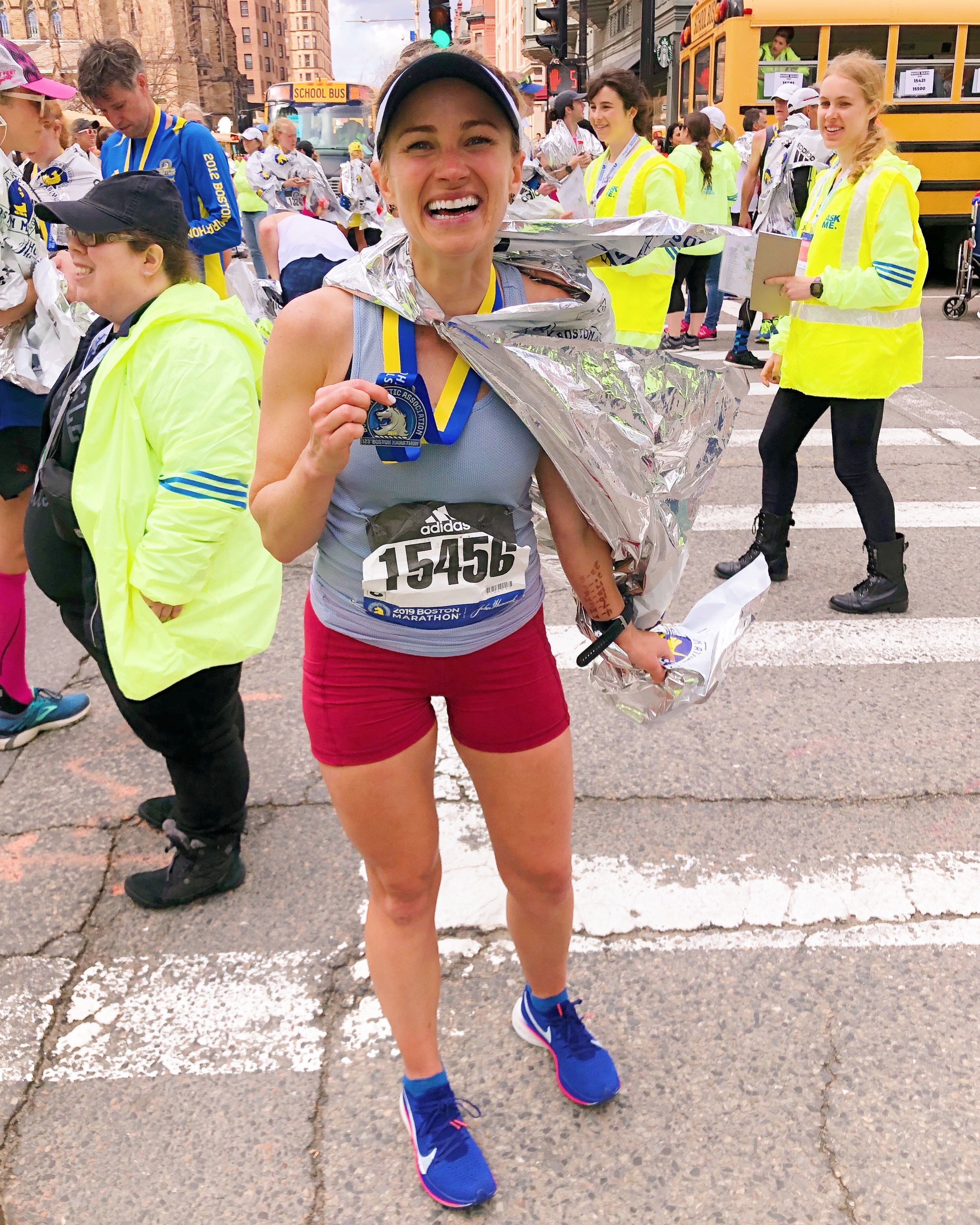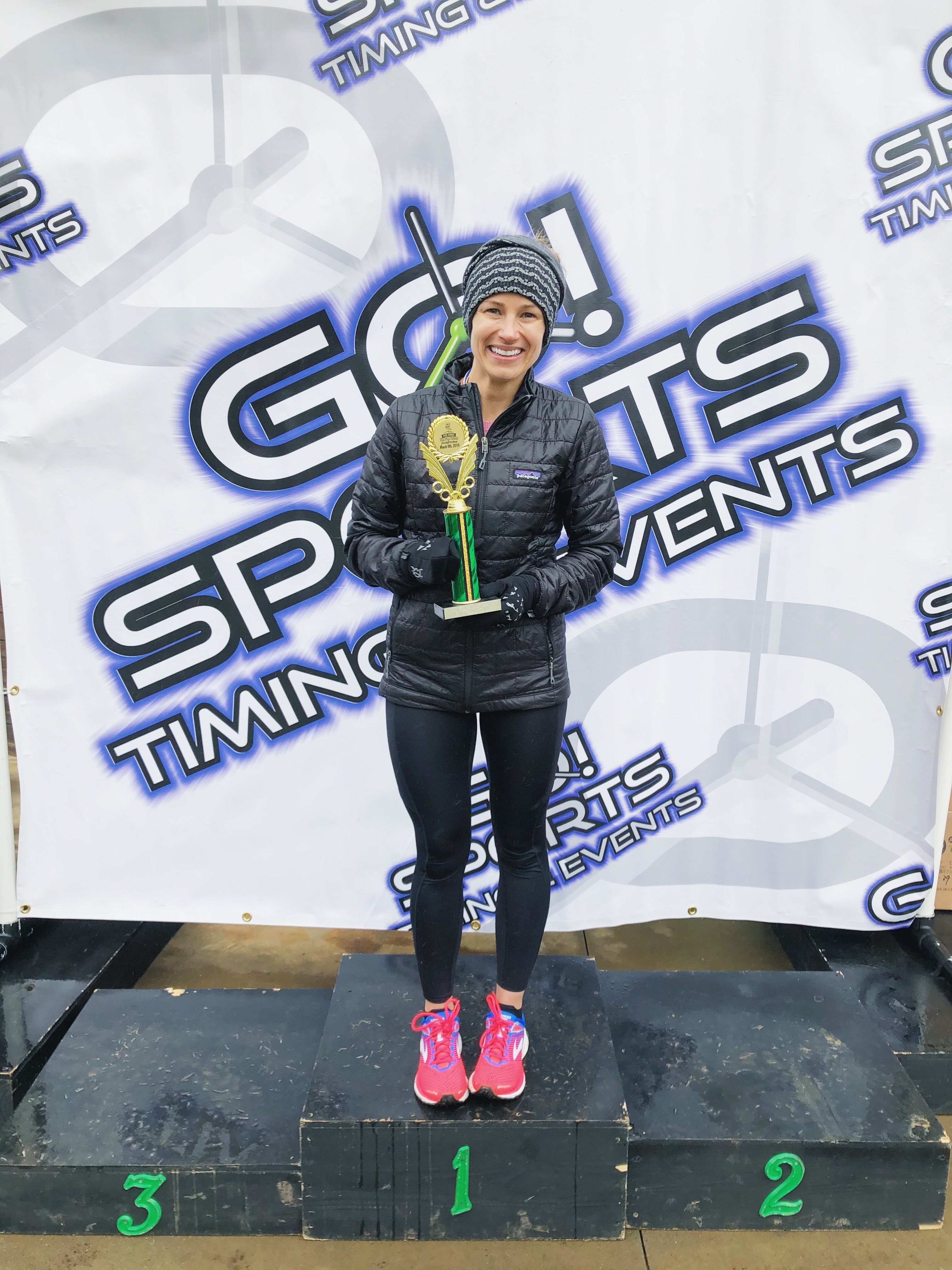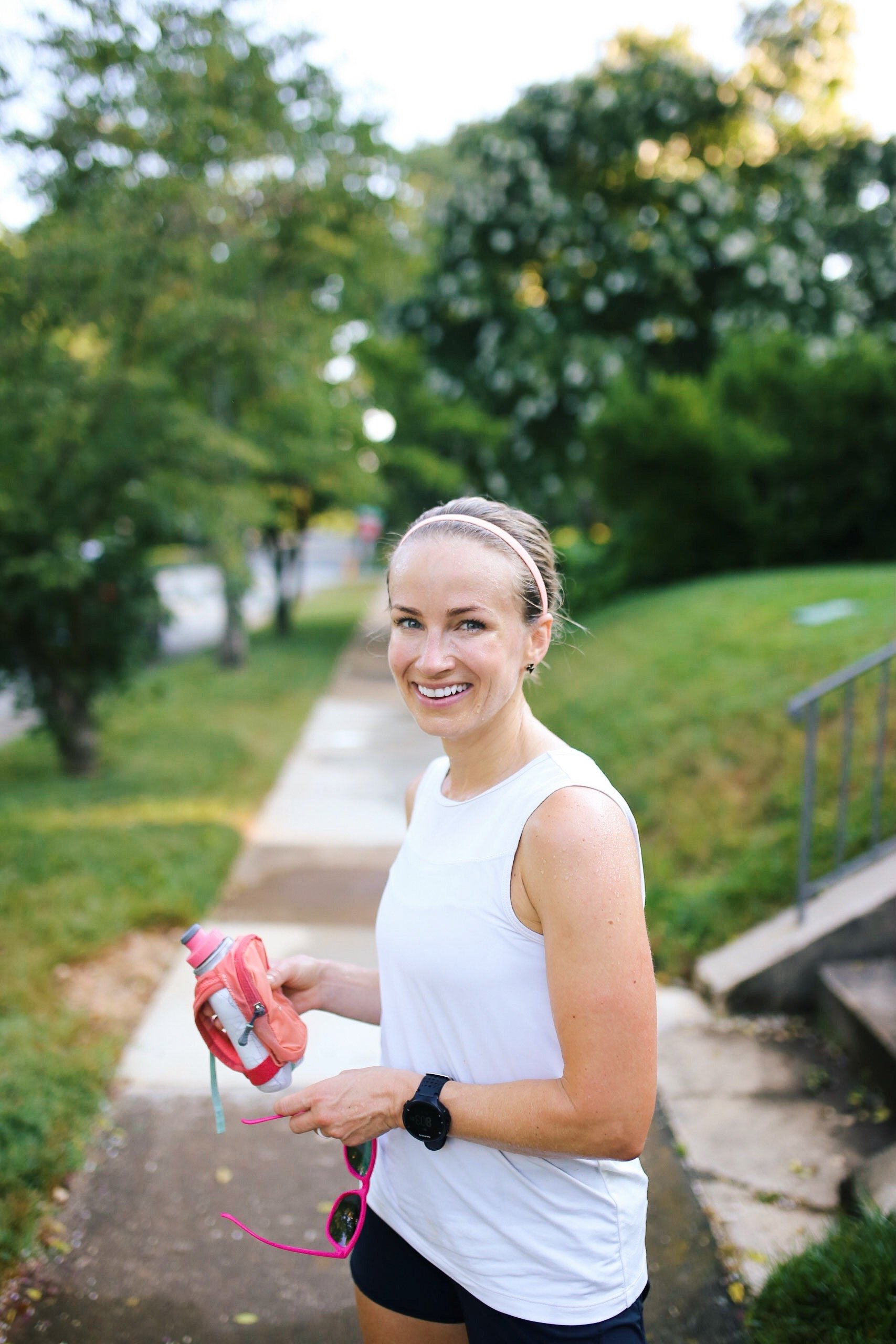The following content may contain affiliate links. When you click and shop the links, we receive a commission.
Whether you’re new to running or have been logging miles for a while, there is always something you can focus on with running. And the key to a lifelong love of running is to enjoy the process as much as the race day results. But, it’s fair to want to run faster and it’s a common goal for almost every runner at some point.
I wrote in my journal when I was 20 that I wanted to qualify for the Boston Marathon but never remotely believed I could, and I’ve since run it twice. I’ve placed in my age group at multiple races, won a couple in the women’s division, and even outright won a race once, beating all the men. (Gotta love small races!)
Remember, speed is ALL relative. My times may look slow to some yet impossible to others. And remember that people feel the same way about YOUR running speed, regardless of what it is. (You can see an outline below of my race time over the years.)
I wouldn’t say I was born naturally fast. When I started running around age 14, my training runs were in the 10-11 minute mile range, and it wasn’t until I was about 25 that I started to focus on running faster. Then, for the next 10 years, I’ve worked very hard to improve my race times, followed many training plans and even hired my first running coach one year which led to a huge PR in the marathon (at the 2019 Boston Marathon, no less, a notoriously hard course).
Now, I’m returning to running after a rough delivery with my second baby (which involved emergency surgery the day after) so I’m taking my own advice to rebuild speed — and it’s working again.
Alright, let’s get into the tips.
The Truth about Running Faster: It’s a Long Game
Spoiler alert: There isn’t one thing you can do to run faster, but rather it takes a combination of things.
The best answer I have is to keep putting in the work consistently for years.
It’s not entirely unreasonable to expect some improvements in speed right away, especially if you’re a new runner. But it’s also not reasonable to expect huge improvements after just a couple months.
Huge improvements in running speed take years to discover. And what’s especially exciting about that is that you really don’t know how much faster you’ll get over time. If you cut 15 seconds per mile off in your first 3 months of running, that’s awesome. But you may end up cutting 2 minutes off per mile after years of work. There is so much untapped potential when you’re new since you just don’t really know your body yet. And again, this is where focusing on the process is so important because that’s where the real work — and results — happen.
Learning to love the process and identifying progress in training will help you enjoy race day even more, regardless of whether you meet your goal or not. I always think of race day as a celebration of my work. Yes, I set race day goals, but the majority of joy that running gives me comes from the day-to-day miles and workouts, not solely a finish line.

First, evaluate your training.
So what if you’ve been running for years and don’t feel like you’re getting faster? I would ask you to evaluate a few things:
- Do you run only steady pace miles?
- Are all your speed workouts the same distance and pace?
- How hard do you really push in your workouts?
- Do you prioritize recovery? How many hours do you sleep each night?
- What does your diet look like? What about alcohol intake?
- Are you comfortable with being uncomfortable?
- Are you consistent day after day, week after week, month after month, and year after year? Do you take large chunks of time off from running?
Go through that list, honestly answer each and evaluate it. Yes, there will be periods where an injury or life causes a setback or limits your training. Factor that into your goals as well. But a long, healthy running career is consistent, even through life’s inconsistencies.
Sometimes, consistency is being really diligent with PT to recover from an injury. Other times, it’s recognizing that you’re in a period of life where it’s not reasonable to put in consistent training and manage your own expectations.
Okay, now keeping the answers to those questions above in mind, here are seven tips to improve on each point.
How to run faster – 7 tips to incorporate into your training
1. Do interval training
You won’t get faster if you don’t practice running faster and really push yourself (more on that in #3). I first started running intervals on the treadmill, mostly because I kept getting bored on the treadmill. And then I noticed how much my “fast” speed on the treadmill started improving, and it motivated me to keep pushing the pace.
I didn’t do anything formal at first: I just warmed up for about a mile and then started alternating between running at a fast pace for 30-60 seconds and a slower pace for 30-90 seconds. I also tried to increase my speed one notch with each fast interval. My faster pace was anywhere from 5:45 – 6:30 min/mile and recovery around 8:30-8:45 min/mile.
Fartleks and strides are another way to break up steady running pace without doing formal intervals. Adding in fartleks mid-run or strides at the end of your runs a few times a week will improve your running form (even your posture!). Good form will also improve your running economy, which will also help with speed. Fartleks simply means “speed play,” where you vary your pace throughout the run, and strides are 4-6 bursts of fast running for about 100 meters.
This post explains more benefits of sprinting.
If you’re not familiar with “fartleks”, “strides” or other running terms, you’ll find the Running Dictionary in my running course helpful.

2. Vary your workouts.
When I got serious about beating my PRs, my speed training became much more structured and specific for the next goal race on the calendar. Depending on where I was in my training cycle, I incorporated some short intervals, tempo runs, and long runs with pace changes. Lots of variety creates different stimuli, which drives change and improvement.
Your workouts – both in distance and pace – should be tailored to your goals. If you’re trying to break your 5K PR, that will look dramatically different than a marathon training plan. A good training plan should incorporate speed workouts specific to your race distance. And once you’re more experienced, putting in more miles each week, including some longer distances, will improve your base fitness.
And don’t forget about strength workouts. Increasing strength in both your upper body and lower body will make you a more efficient and more powerful runner, which translates to speed. Some of my favorite Peloton workouts are the Strength for Runners classes.
3. Run with runners who are faster than you.
I never really set out to improve my running speed or race times. It was fun when it happened, but when I started seeing big improvements in pace and race times was when I started running with people much faster than me.
And yes, a lot of the time, it sucked running with them. I was frustrated that their “easy” pace was killer for me and embarrassed when I had to ask them to slow down or just go on without me.
But my ego is such that I worked my butt off to keep up as best I could and, eventually, my easy pace re-calibrated. My easy pace used to be a 9:30 – 11:00 min/mile and for long runs, my easy pace dropped down to 8:15-8:45 min/mile. (And if I’m marathon training, my recovery runs will still tip into 9 and 10 minute miles.)
4. Stop getting injured.
If you are constantly battling an injury, it’s going to be hard to push yourself while running. And if you can’t push yourself, it’ll be hard to make improvements. While I still struggle with injuries from time to time (a torn posterior tibial tendon most recently, as well as c-section recovery), I’ve learned to address aches/pains from overuse injuries sooner than later.
To help with injury prevention, I try to be proactive and somewhat regular with yoga or cross training, dry needling, chiropractic adjustments, strength training (particularly core and hip work, with focus on some upper body muscles too), and massage.
If you aren’t doing strength training weekly, start. It’s beneficial for all runners, especially those trying to improve their speed. Strengthening your leg muscles (glutes, hamstrings, core muscles, etc) will make you stronger AND faster. Tack a small amount of strength work (a few squats, lunges, heel calf raises, and plank holds) onto the end of your run if you have time. This is a great way to work on your stability too.
Double check that your shoes aren’t too old, since this can lead to a multitude of injuries, especially in your feet and knees. If you need to get a new pair of shoes, do it– see my favorite running shoes here. It will be cheaper than having to see a physical therapist. I try to make my running shoes last as long as possible, but when I know it’s time for a new pair, I don’t hesitate.
Read more tips for how I keep injuries at bay here. And read how to come back from a running injury here.
And don’t forget to prioritize sleep.
Runners need 7-9 hours per night. More and more research is showing that sleep is the MOST important recovery tool out there. And make sure your easy days are TRULY easy. Keeping an eye on your heart rate is a good way to do this. Aim for 65-70% of your max heart rate. You can also run with a slower friend and talk the whole time to keep your slow runs slow. Conversational pace is a good gauge for an easy run.
5. Evaluate your diet.
I used to not think much about what I ate before and after a run. I always had something, but I wasn’t very intentional about it. While I try not to obsess over food, I am very intentional with my diet to fuel my running goals — particularly with what I eat before a run and what I eat after a run.
In order to run your best, you MUST be properly fueled. And carbs should be a large portion of your diet — likely more than you realize.
When I was training for the 2019 Boston Marathon, I had my diet while marathon training analyzed by a registered dietitian who specializes in sports performance. He identified that I was significantly under-fueling. While my protein intake was adequate, I wasn’t getting enough carbs to support the mileage and high intensity I was putting in. Read what he suggested I change in my diet here. And when I made the changes, I actually lost weight by eating more.
Over the years my body weight has fluctuated. But being lighter does NOT always equal faster. I set my marathon PR at one of my heaviest weights. The moral of the story is if you aren’t at a healthy weight — either too heavy or too thin — it may limit your potential. Find a healthy weight where you feel good and makes sense for your body type. That may mean you need to lose weight or gain weight. Being too light can also lead to injuries and more serious problems as it relates to your relationship with food.
Consider reducing alcohol
When I’m training for a big goal, I don’t drink alcohol.
Even when I’m not in training mode, I rarely have more than 1-2 glasses a week. If I drink more than that (in terms of number of days or glasses at one time), I really feel it on my runs, and I’m significantly more tired throughout the day. So it’s just not worth it to me.
6. Learn to embrace discomfort.
I used to have the motto that I run because I enjoy it and if I push too hard, I won’t enjoy it. And that motto was fine for a time.
But then I wanted to get faster and that motto can’t apply when working on speed. I had to learn to deal with discomfort from pushing the pace and also know the difference between discomfort and pain. Now, I almost always prefer a workout to a steady state run.
Make sure to warm up with dynamic exercises, since this will help make the first few miles more comfortable. It’s one of my top ways to make running easier.
Running a race will also help you learn to embrace discomfort. You’ll push yourself harder in a race than you will on a regular training run, so this is especially helpful if you just don’t like pushing yourself. Plus, you’ll be energized by the running community, which helps you stay motivated and excited about running.
And when I inevitably start to fatigue during extra hard workouts or races, here’s what helps me cope:
- visualizing how good it feels when I beat my PR
- channeling any stress I have into the discomfort
- reminding myself that it SHOULD feel hard, that the paces should NOT come easily
- repeating mantras
- counting how often my foot hits the ground – this helps me focus on my cadence, which improves running economy
My favorite training mantra is “This is what you’re here for.” For race day, I like “I trained for this feeling.” and “The faster I run, the sooner I’m done.”
7. Are you consistent? Recognize and celebrate improvements along the way.
If you aren’t consistent, it’s going to be hard to see those big breakthroughs. Yes, rest days are important and some time off may be forced due to an injury. But if you only train in spurts, with more time off than on, you are less likely to make meaningful improvements in speed.
So what if you ARE consistent? It can be hard to see that you are actually working towards a big breakthrough. But it really is the day-to-day things built over weeks, months, and years that lead to big improvements in speed.
That’s where having a long-term perspective can be helpful and where recognizing improvements along the way will help you stay motivated before those big throughs.
You may drop big chunks of time off your races in the beginning. Or your may not. You may be at the point where even 3 seconds faster is a win. Or maybe the win on any given day is remembering to stretch after every workout. You may run significantly slower in the heat but you still get out there and run in it. (Here are my tips for running in the heat.)
Part of the key to staying motivated long-term is to remember WHY you started running in the first place and celebrating along the way, not only at big breakthroughs. Again, process over outcome.

My race times and how I Increased My Running Speed
Running faster wasn’t something that happened overnight—it took intentional training, a willingness to get uncomfortable, and a big focus on recovery and consistency. By mixing up my runs with intervals and tempos, learning to actually push myself during workouts, and making sure I wasn’t skipping strength training, I was able to shave significant time off my race paces. Prioritizing sleep, eating to fuel performance, and staying patient with the process made a huge difference too. If you’re trying to run faster, remember: it’s not just about running harder—it’s about training smarter, recovering better, and trusting that the work will pay off.
Here is some proof:
The first ever race I ever ran was the Moab Half Marathon in 2005, which I ran in 1 hour, 57 minutes.
My next race was a Ragnar Relay and then a 5K, which I ran in 25:56.
When I ran my first marathon in 2009, took me 4 hours, 6 minutes.
Now, years after my first race and 50+ races later, my current PRs are:
That means I’ve cut the following time off my races:
- 27 minutes in the half
- 49 minutes in the marathon
- 5+ minutes in the 5K
A final thought on what else has helped my speed: age + wisdom
I got older. I’ve read before that women reach their peak in running from about 28-38. It might be a coincidence since I’ve also started training harder as I’ve gotten older.
But more importantly, I’ve gotten wiser (most of the time) and listen to my body when it really needs more recovery or more fuel — or to be pushed a little harder.
And yes, at some point, you’ll eventually slow down. But more and more runners are continuing to tap into faster speeds later in life, both in the recreational and elite runner populations. (And I love hearing about it since I’m officially in the masters runners category, now that I’m over 40!)
It’s taken years of hard work, but I still believe I have more speed in me. And that’s exciting. And you probably have more in you too.

You may also find these helpful:
My Must-Have Running Gear
terilynadams.com (Article Sourced Website)
#Run #Faster #Proven #Tips #Improve #Speed #Endurance
